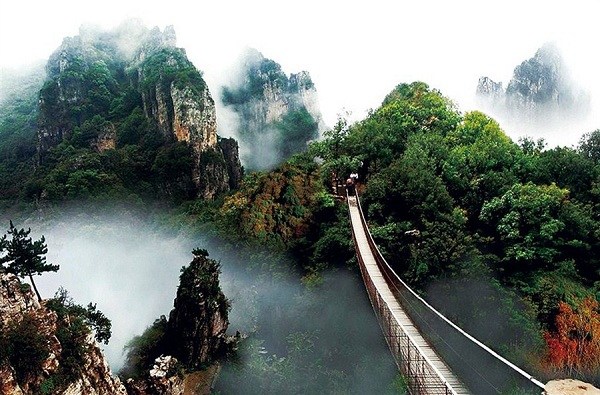Wulaofeng bursting with attractions
 0 Comment(s)
0 Comment(s) Print
Print E-mail Shanghai Daily, January 22, 2016
E-mail Shanghai Daily, January 22, 2016
The Wulaofeng National Park is located about 16 kilometers southeast of Yongji City, in north China's Shanxi Province. In addition to its enthralling scenery, the Wulaofeng area has long been regarded as an epicenter of both Taoism as well as Heluo culture, one of the earliest Chinese civilizations.
Yongji Wulaofeng is blessed with an abundance of trails and spectacular views. It is also home to more than 60 Taoist temples, palaces, nunneries and alters, some originally built as early as the Northern Zhou Dynasty (AD 557-581). Many of these have been preserved, rebuilt, repaired and expanded; and are still operating today.
Aside from the Wulaofeng scenic area, the park is also home to China's largest Guan Di Temple, the Yuncheng Salt Lake, the Yellow River Iron Oxen casts and the Guanque Tower.
China is filled with countless temples dedicated to the Three Kingdoms era (AD 220-280) warrior and sovereign Guan Yu, but the one in Shanxi is considered the finest and most famous. This is often attributed to the fact that Guan himself was born in nearby Changping Village. The temple was first built by imperial decree in the year 589.
The salt lake in Yuncheng covers an area of 132 square kilometers, making it one of the largest lakes of its kind in the country. Due to its high salt and mineral content, bathers can easily float in its soothing waters. The lake's black mud is also used to make skin care products and cosmetics. A health resort opened along the lake in 2002.
Situated along the Yellow River, which runs through the area, are four magnificent cast-iron oxen, each weighing upward of 75 tons. These statues once served to anchor a wooden bridge at an important Yellow River salt port beginning in the 7th century.
The river has changed course several times since then. Although discovered in the mud by locals in the 1970s, the oxen were raised only two decades later. They were first put on display on a raised outdoor plinth in 2005.
The oxen are accompanied by equally ancient statues of male figures. Their fluid muscles, acrobatic stance and knowing expressions are reminiscent of Rodin, but were created more than a millennium before the birth of the French master.
The Guanque Tower also stands at the bank of the Yellow River. Known as one of the "four famous historic towers" in ancient China, the tower was destroyed during a war in the Yuan Dynasty (1271-1368), but was later rebuilt in imitation of its original Tang Dynasty (AD 618-907) design. Thanks to its craftsmanship and surrounding scenery, the tower was a frequent subject among poets and literati of the Tang and Song (960-1279) dynasties.







